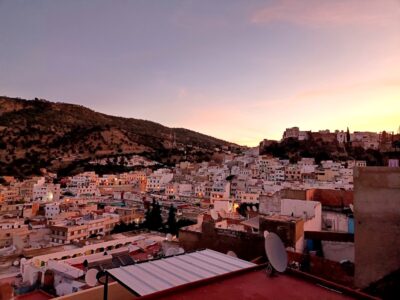
On my first night in Morocco, I had roast chicken, pickles and flat bread for dinner in an eatery that was just a stone’s throw away from my hotel in Casablanca. And though the dinner was nothing special, I remember the huge servings and the fact that I ate a lot of bread at a very reasonable price. It was also the first time I tasted the Moroccan staple khobz – a round, flattish bread that looks like a giant pandesal – the breadcrumb-covered breakfast rolls of my childhood in Manila. Post that, I went on to cap the hearty dinner with a “shot of Moroccan whiskey” at a nearby café.
This was also the time I had my first taste of real Moroccan mint tea. A combination of gunpowder green tea and mint leaves, I drank it over and over again along with one of the best and cheapest espresso shots. The cafes were easy to find as our tour group moved from one place to another by train, van and bus before concluding the tour in Marrakech.
Bread, coffee and tea – it’s how I would always remember my whistle-stop group tour around Northern Morocco in November 2023. It was mostly about the bread, and the fact that no matter how much I loved eating it, I also spent days craving for and searching (in vain) for a warm bowl of fluffy Thai Jasmine rice.
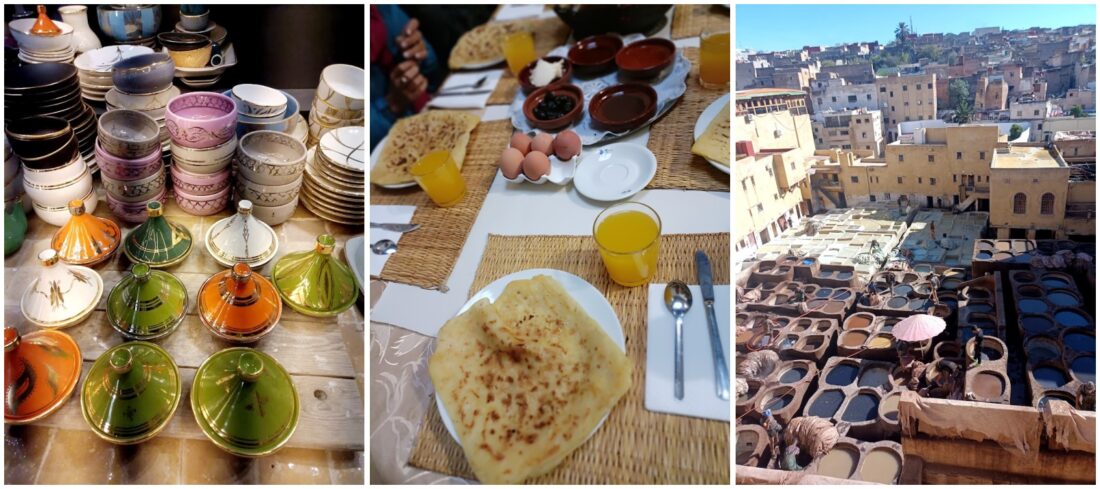
C – This is the msemen – a square, pancake-like flat bread. I ate this for breakfast with cottage cheese, olives, honey and jam.
R – Tannery at the Medina in Fez
The trip was not just my first time in Morocco but also my first on the African continent. Since it’s situated in North Africa and is a Muslim-majority country – I lumped Morocco with other countries in the MENA region. Weeks before my trip, I deliberately avoided any Middle Eastern or Indian restaurants in Hong Kong because I was dreaming of eating lots of flat bread, hummus and baba ganoush, and alternating that with basmati rice, shawarma and kebab.
I should have known better, or at least have managed my expectations had I done a bit of research. I would have known, for example, that wheat is widely grown in Morocco and has been cultivated here for thousands of years, with cultivation practices adopted to suit the country’s semi-arid climate.
I should have seen the giant clue when, while checking the colorful tiles that decorated the walls of the Hasan 2 mosque in Casablanca – the guide said that Moroccans are not Arabs – they’re Berbers. Better yet, call them the Amazigh as the word Berber is derived from the Arabic word that means barbarians. The Amazigh are the indigenous group in North Africa, and the guide said that the Arabs came into Morocco to spread the Islamic religion, and then left.
I do love bread – it’s not easy not to, even if my traditional Chinese Medicine doctor has advised me to eat more rice as this is better suited to my body. Eat what your ancestors eat, Doctor Clara told me as she inserted a thin steel need into the skin on my upper back while I laid face down on the therapy bed. But how can I resist bread? I grew up having pandesal for breakfast. In Hong Kong, where I have been based since 2018, there are at least one or two bakeries in any densely populated neighbourhood, each store offering an array of egg tarts, sliced bread and sweet buns.
And in Morocco, in my first two to three days at least, I enjoyed the novelty of eating different kinds of bread during breakfast. My favorite was my breakfast at a guesthouse in Meknes, Morocco’s former capital. I am no morning person but I enjoyed waking up at dawn to go to the balcony, listen to the sound of azhan and then go down to the dining room for a spread of coffee, mint tea, boiled eggs, orange juice and baguette. There’s also the sfenj, which looks like a fried doughnut, and msemen, a square, pancake-like flat bread. We ate them with cottage cheese, olives, honey and jam. We needed all that carb load as we hiked the nearby archaeological site of Volubilis – where the ruins of the city, once part of the ancient Roman empire, remain.
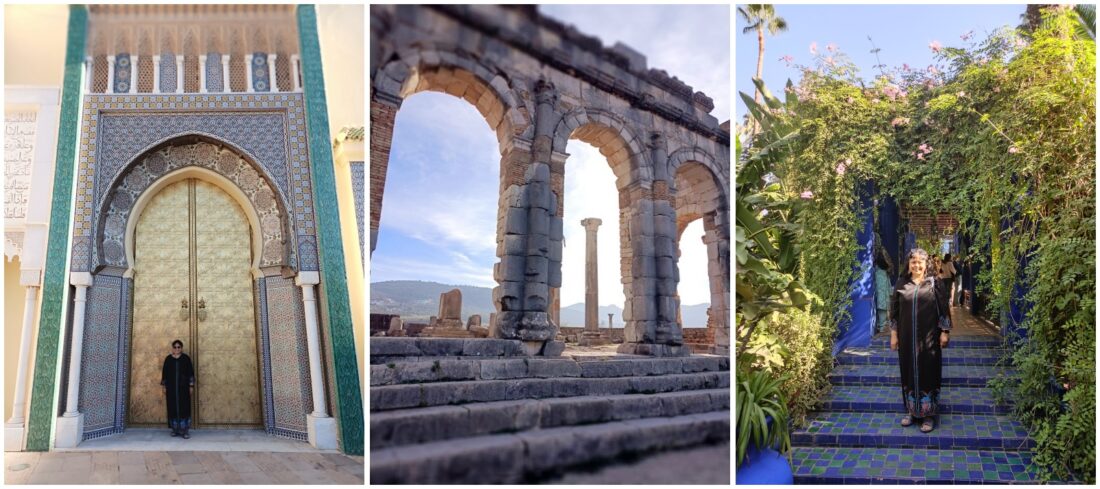
C – The archaeological site of Volubilis – where the ruins of the Moroccan city that once part of the ancient Roman empire remain.
R – The oasis that is Jardin Majorelle – a botanical garden in a middle of Marrakech but it more known as the museum (and once upon a time the vacation house) of the late French designer Yves Saint-Laurent.
In the evening, as the residents prepare for maghrib prayers, we explored the narrow alleyways of Meknes, where we got to see the furan – the communal oven where we see bakers putting the dough delivered by residents to be baked into khobz in a wood-fired furnace. The baker gave us pieces of khobz, I ate some of it, but spent most of my time hanging around the areas as I savored the aroma of newly-baked breads and the warmth of the oven amid a chilly autumn evening.
Now, I can’t exactly pinpoint the time I started getting tired of all these bread that I was eating, but I remembered that the last time I enjoyed eating khobz was when I tasted camel burger for the first time in a guesthouse in Fez. I never thought that camel meat could be that juicy and tasty, but I was disabused of that impression after the guide told me that the burger was mixed with beef because pure camel meat is tough. Never mind, I thought and just used those extra calories getting lost in the maze that is the medina of Fez, where I went to see a tannery and bought leather handbag. Then I got my picture taken in front of the Royal Palace, which is the palace of the country’s monarch. And since we could not enter, I made myself content by looking at the bronze door and the elaborate mosaic tilework that decorate most of the historic and grand buildings in Morocco.
The problem with bread, according to my Malaysian friend Evelyn, is that eating a slice of bread is not as filing and satiating as eating a cup of rice. Unlike rice, you can eat a lot of bread and still don’t feel full, she told me. I sort of agreed, but qualified that I get satiated after eating a tuna sandwich or about two to three slices of bread. But bread, even if it’s homemade and freshly-baked, feels cold and heavy in my stomach. A cup of steamed rice, meanwhile, feels warm, nourishing and familiar.
It was that longing for rice that spurred me to order basmati rice when I saw it on a menu in a restaurant in a medina in Tangier. Not only did the waiter take almost an hour to serve my order – the rice was soggy and cold. It was such a bad lunch that I had to go straight to the famous Café Hafa. I had another espresso in a café located at the cliff top overlooking the Bay of Tangier. A cold afternoon with a warm cup of coffee and the view was fantastic.
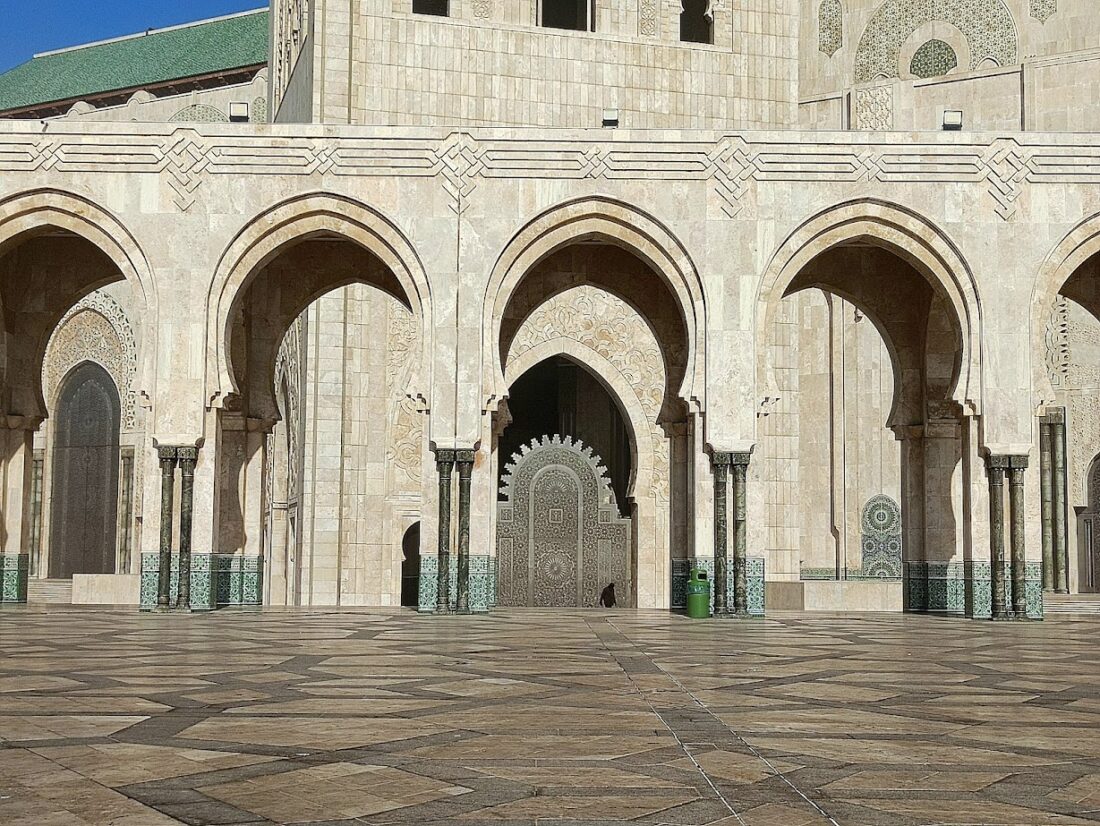
Of course, I did try again when we had dinner in a rooftop restaurant in a medina in Marrakech – with the same result. Long wait. Cold rice. I tried to bury that memory by having a glass of wine afterwards and spent the day wandering the oasis that is Jardin Majorelle – a botanical garden in the middle of a city, it is known more as the museum (and once upon a time the vacation house) of the late French designer Yves Saint-Laurent.
After about a week in Morocco, I returned to Hong Kong. And in the next few weeks, or probably months, I cooked rice, ordered rice – Thai jasmine white rice, organic Philippine brown rice, and Japonica rice – and ate lots and lots of rice.
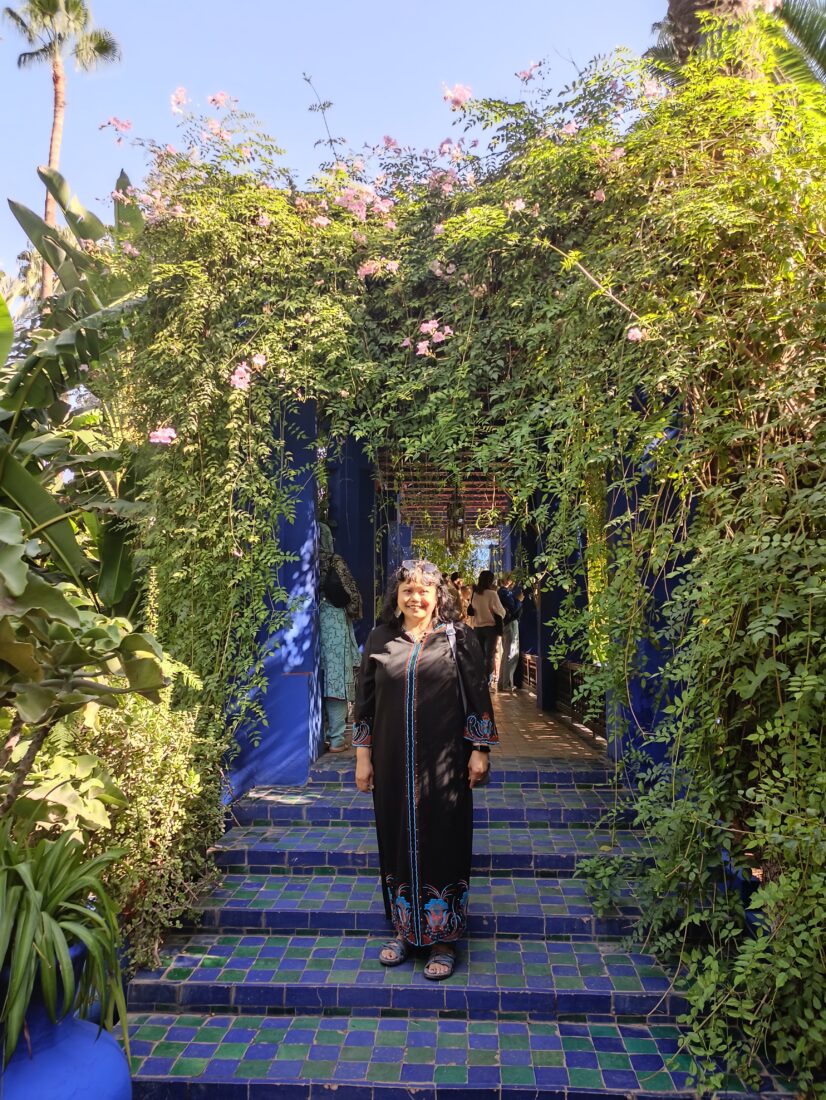
Prime Sarmiento
Prime Sarmiento is a Hong Kong-based Filipina journalist. She writes about ASEAN business and economics for a living, but writes creative non-fiction to have a life. She blogs on and off at https://primesarmiento.com.
